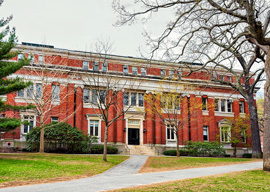
September 20, 2017

Emerson Hall, Harvard University
Source: Bigstock
In 2011 at the Yale Law School, according to professors Amy Chua and Jed Rubenfeld, only two of the eighteen students who joined the black students’ association were African-American on both parents’ sides.
In 2004, black Harvard professors Henry Louis Gates and Lani Guinier pointed out that only about one-third of Harvard’s 530 black undergraduates were the descendants of four African-Americans. With the rise of Barack Obama later that year, however, Gates and Guinier prudently dummied up on this interesting question of why American institutions are granting racial privileges to individuals with no claim to be hereditary victims of slavery or Jim Crow.
It just doesn’t seem like the kind of question that occurs to white people in these increasingly racialized days. For example, Dana Goldstein’s “When Affirmative Action Isn’t Enough” in The New York Times on 9/17/17 focused on Elvis Kahoro, an illegal immigrant who was admitted to posh Pomona College in Claremont, Calif.:
To lure Mr. Kahoro, who was born in Kenya, Pomona went to extraordinary lengths. It flew him to campus during the fall of his senior year, paying for all his travel expenses. After he was accepted, financial aid covered close to the full cost of attendance, and he has never had to take out a loan; the college even gives him extra money for textbooks and cross-country trips to visit his family.
As with President Obama, Mr. Kahoro’s ancestors presumably sold many blacks into the slave trade. But that doesn’t matter in America in 2017: Elvis is racially entitled, even if recruiting him away from other colleges desperate for minimally qualified blacks is an expensive zero-sum game.
Here’s one important question that the superior performance of Africans and West Indians raises: Is something radically wrong with African-American culture? Why aren’t black Americans doing better than blacks from much poorer countries? Is our American culture of inculcating racial resentment causing African-Americans to lag behind their distant cousins from abroad? Should we stop allowing so many foreign blacks to immigrate?
Another relevant question: Do immigrants who get drafted into ameliorating American academia’s black lack eventually come down with the same bad habits as African-Americans?
Although the NYT article celebrates Pomona College for its costly success in attracting underrepresented minorities, Pomona and the other Claremont colleges, such as Claremont McKenna and Harvey Mudd, have suffered major nervous breakdowns in 2017 by black and Hispanic students who are thrown in over their heads. In August, the NYT profiled the spate of childish meltdowns in Claremont this year under the apt headline: “More Diversity Means More Demands.”
After a half century of America obsessing over theoretically overlooked blacks, where is the actual ignored talent?
Caroline M. Hoxby of Stanford and Christopher Avery of Harvard have been studying who are the high-potential high school students who don’t think about applying to, say, Stanford or Harvard.
These ignored students tend to be not the more fashionable ethnicities, because our society has been fixated upon recruiting blacks and Latinos for a half century now, but, typically, white boys in flyover states. The most disregarded students today are the same kind of people who got us to the moon in 1969.